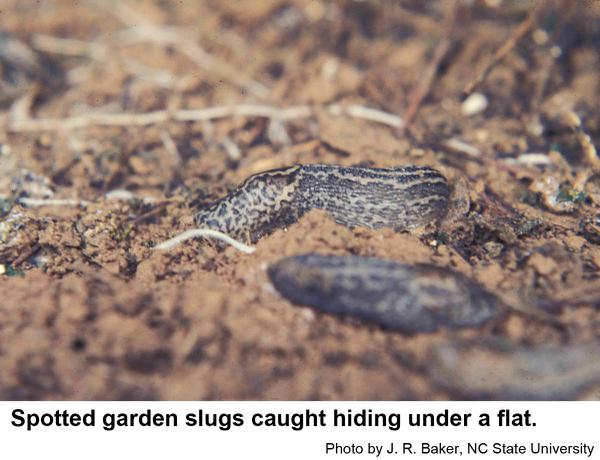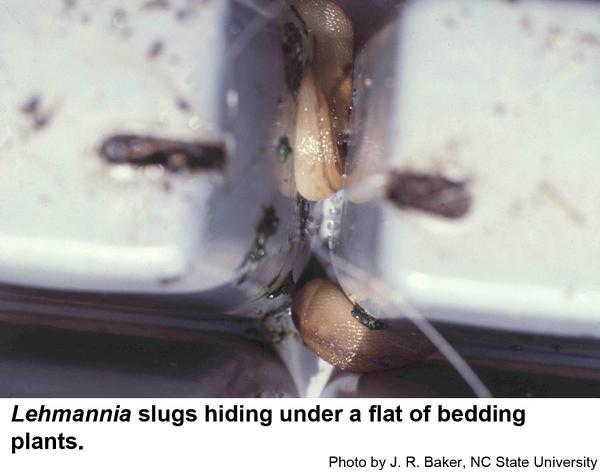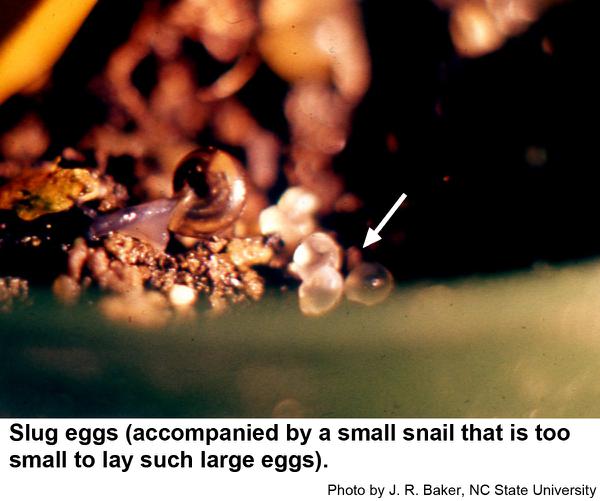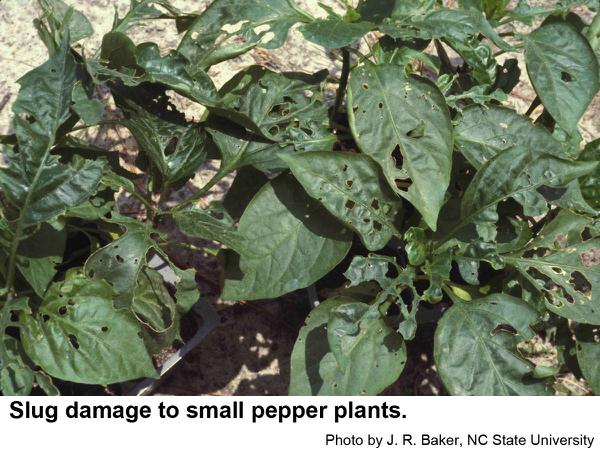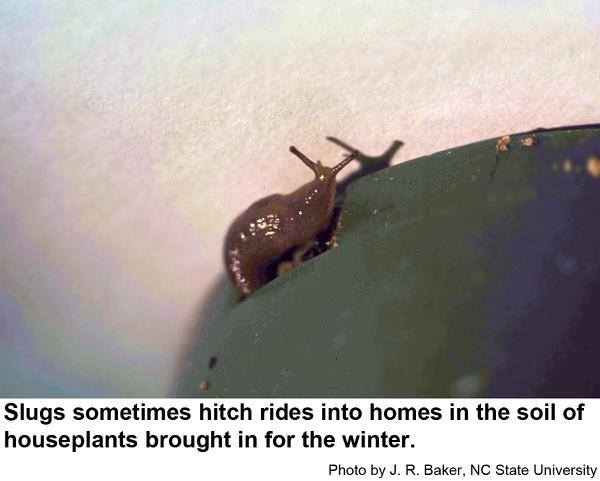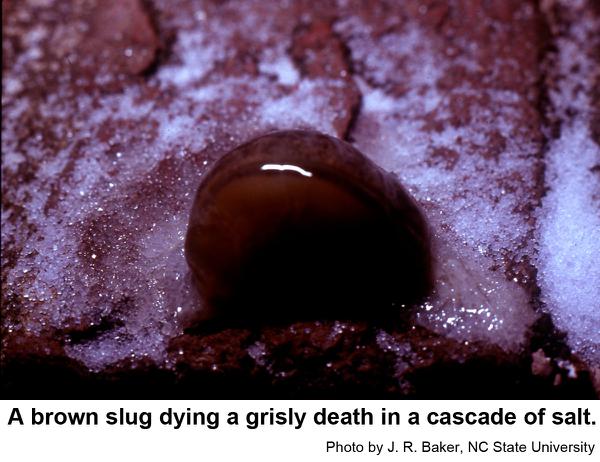General Information
Slugs are soft, slimy, slender animals more closely related to octopi than insects. Those slugs that are important plant pests have been accidentally introduced primarily from Europe (Native slugs are wider and the mantle seems to cover the entire back. Furthermore, our native slugs rarely if ever attack plants.). Adult slugs have stalked eyes and two small feelers below, and they have an oval fold toward the front called the mantle.The breathing hole is on the right side of the mantle. The spotted garden slug, Limas maximus, can grow from 3 to 5 or even more inches long. The tree slug, Lehmannia poirieri, grows to about 2 3/8 inches long. Mature garden slugs, Arion hortensis; brown slugs, Deroceras laeve; and gray garden slugs, Deroceras reticulatum; grow 1 to 2 inches long. Slugs have various spots and stripes. Slug eggs are oval and about 1/8 inch long. They are clear or opaque and cream or yellow. Eggs are usually laid in masses, sometimes in a gelatin-like substance.
Biology
Mature slugs lay eggs anytime throughout the growing season. Eggs are laid in batches of 20, 30 or more under boards, pots or in the soil. Eggs are resistant to drying out, but their development may be delayed until sufficient moisture is available. Teeny slugs hatch and begin to feed and grow. Young slugs develop relatively slowly. Slugs may take up to a year to mature. Young slugs are males that become hermaphrodites (and can even self-fertilize!). Mature slugs are female. During bright, warm weather, slugs hide under boards, stones, debris or tunnel into the soil. At night, especially in warm, humid weather, slugs feed on decaying organic matter and succulent plants. Their mouthparts resemble tiny rasps, and they rasp away plant tissue and suck up the residue. Slugs feed on many kinds of plants but they tend to stick with one plant, often consuming it entirely before moving on. A gland under the head produces two types of slime or mucus. One mucus is very free-flowing and the other is viscous. These mucuses combine to form the slime trails along which slugs glide. These slime trails often glisten in the morning. Mucus is produced in smaller quantities over the entire outside of the body. Different types of mucus are produced for moisture control, mating, and defense. When attacked, a slug produces an extra-thick mucus that makes the slug hard to pick up. This defense mucus is also capable of gumming up the mouths of such predators as snakes and shrews and can cause dogs and ducks to gag. Slugs can live up to 6 years.
Snails will have a similar biology, but secrete and carry a shell (the shells of slugs are internal). Although we have more than 700 species of snails, they are of minor importance compared to the 40 or so pest species of slugs. The brown garden snail and the African garden snail are veritable plant pests that can consume seedlings and eat large ragged holes in foliage. Fortunately neither snail has successfully colonized North Carolina.
Host Plants
Slugs feed on the leaves and flowers of many ornamental, vegetable and field crops. They are most damaging to tender, young crops in spring. Slug damage on foliage usually appears between the veins and on leaf margins. Small slugs rasp away the leaf or petal surface. Medium slugs often eat holes. Large slugs consume whole leaves, petals and sometimes entire plants if the plants are small, A silvery slime trail is left behind. Greenhouse slugs, Milax gagates, tunnel through soil and feed on roots. Slugs are active at night and during cloudy, warm weather. During bright warm weather, slugs usually hide under boards, stones, debris or tunnel into the soil. At night, especially in warm, humid weather, slugs feed on decaying organic matter and succulent plants. Their mouthparts resemble tiny rasps, and they rasp away plant tissue and suck up the residue. Slugs feed on many kinds of plants but they tend to stick with one plant, often consuming it entirely before moving on.
Residential Recommendations
Slug populations can be reduced by eliminating their breeding and hiding places Remove rotting boards, logs, pots and other debris from the area. Compost or destroy plant refuse and properly stack (off of the ground) flats and other materials that provide shelter for slugs. Trim tall grass and weeds along fences and ditches in the vicinity of susceptible crops. In plant beds and gardens, place boards or other flat objects on the soil. These traps should be at least 6 by 6 in. Each morning remove the slugs from beneath the traps and destroy them.
For snails in water gardens, float lettuce or cabbage leaves on the water surface over night. Remove the leaves with any attached snails every morning until no more are found.
Of the baits used for slug control, metaldehyde is the most common. Metaldehyde kills by dehydration and works best if the slugs do not have a convenient source of free water nearby. Carbaryl and other carbamate baits become even more toxic if intoxicated slug can get to water. Iron phosphate products are labeled safe around pets. For best control, apply the molluscicide on a warm, clear night under boards or other traps. Two or more treatments at 5 to 7 day intervals may be necessary to obtain adequate control. Some people have been known to kill slugs with table salt, but salt is toxic to plants. Copper is repellant to slugs; copper strips have been used as barriers to slugs. Iron phosphate is another relatively safe molluscicide that is available in most big box stores, plant centers, and nurseries. It causes slugs and snails to cease feeding, seek shelter, and die within a few days.
References
- Frequently Asked Questions about Iron Phosphat for Controlling Snails. Armstrong, J. H. 2012 (revised). Florida Dept. Agr. & Consumer Serv.
- Insect and related Pests of Flowers and Foliage Plants. Baker, J. R., ed. 1994. North Carolina Cooperative Extension Service Pub. AG-136. 106 pp.
- Intra- and inter-specific agonistic behavior among terrestrial slugs (Pulmonata: Stylommatophora). Rollo, C. D. and W. G. Wellington. 1979. Canadian Journal of Zoology 57 (4): 846-855.
- Slugs. Nixon, P. No Date. Home, Yard & Garden Pest Newsletter. College of Agricultural, Consumer and Environmental Sciences, University of Illinois at Urbana-Champaign, Illinois Natural History Survey.
- NC State Extension Plant Pathology Publications
- NC State Horticultural Science Publications
- North Carolina Agricultural Chemicals Manual
For assistance with a specific problem, contact your local N.C. Cooperative Extension center.
Publication date: April 1, 1998
Reviewed/Revised: Oct. 9, 2023
Recommendations for the use of agricultural chemicals are included in this publication as a convenience to the reader. The use of brand names and any mention or listing of commercial products or services in this publication does not imply endorsement by NC State University or N.C. A&T State University nor discrimination against similar products or services not mentioned. Individuals who use agricultural chemicals are responsible for ensuring that the intended use complies with current regulations and conforms to the product label. Be sure to obtain current information about usage regulations and examine a current product label before applying any chemical. For assistance, contact your local N.C. Cooperative Extension county center.
N.C. Cooperative Extension prohibits discrimination and harassment regardless of age, color, disability, family and marital status, gender identity, national origin, political beliefs, race, religion, sex (including pregnancy), sexual orientation and veteran status.

